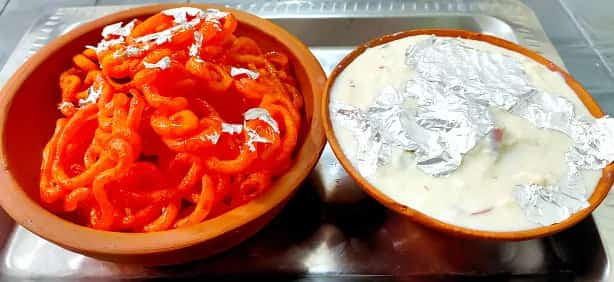Festivals not only help us get over the monotony of daily life but also give us a chance to connect with our roots and celebrate them. One such festive treat is jalebi. Jalebi’s deep-fried batter, made with flour, yogurt, and a host of other ingredients, is dipped in a sugary syrup. They can be eaten plain, with a few sprinklings of sugar, or with rabri (a type of Indian dessert).
Also Read: How The Gulab Jamun Came To India
The jalebi batter is prepared by mixing thickened milk, yogurt, and flour. The mixture is then poured into a round mould with perforated holes at the bottom to form thin, long string-like batter. This is deep-fried in oil (or desi ghee) to make it crispy and golden, and dipped in sugar syrup. The syrup is prepared by dissolving (lots of) sugar in water.
Jalebi is best served warm and can be eaten either as a dessert or a snack, but it’s not something most people would turn down even if it was served cold. A few do prefer the semi-crisp texture that jalebi obtains when it cools down. Others prefer to have jalebi alongside a kadak chai. Gotta love this about India - someone somewhere has already pushed the envelope, recipe-wise, and it probably tastes good too. (We live in the era of paneer dosas, so we're well past the point of sacrilege and reveling in kali yuga.)

The history of the jalebi is buried in the annals of time, but there are several claims about its origins. One such story states that wheat flour, known as “jau” in Hindi, and gud (sugarcane) are the two main ingredients in jalebis. This is why jalebis are also known as “jau gud ki jaleb.” Some claim that the jalebi originated in Gujarat and was invented during the reign of the Mughals. This claim is backed up by the fact that Gujarat is famous for its delicious jalebis.
An alternate, and more widespread, origin story goes like this: The name Jalebi comes from the Arabic word "Zalabia," meaning a sweet dish that is prepared in syrup. The name Zulbiya was first recorded in the 1100s in recipes from an old Persian cookbook called Kitab al-Tabeekh. During the holy month of Ramadan, this sweet is commonly given out to the masses. To this day, it is an essential part of the Nowruz (Persian New Year) celebrations in Iran, where it has been enjoyed for generations. The design of zulbiya is distinct from that of Indian jalebi, with floral coils that are not symmetrical. The Indian jalebi appears like a set of interconnected circular coils.
In India, jalebis are popular during festivals such as Raksha Bandhan and Diwali. The most famous jalebi recipe involves sugar syrup and rose water, but it can also be made with cream, condensed milk, saffron, and pan-fried in ghee. Indians have written songs praising jalebis and most sould never refuse an offer to bite into one. There’s something about that sugary crispness that has us hooked and makes us come up with different versions of the sweet just so we can find excuses to have some more.
Kachori Jalebi
This is a dish that combines kachori and jalebi. If you’re going to indulge, why not go all out? This combo is popular in Bihar, where some even have it as breakfast on certain occasions. This dish has the spice of kachori, and a super-sweet jalebi soaked in sugar syrup. Word to the wise: this can be addictive.
Rabri Jalebi

This combination has jalebi dipped in the milk-based sweet dish rabri (thickened milk). This is indulgence in excess. Rabri was banned (for a year) in Kolkata in the 1960s to stop excess use of milk during an economic recession. Add a few jalebis to the rabri and you have yourself a criminally delicious dessert.
Jaleba
This supersized jalebi requires a special mention. A king size version of jalebi that can reach over 250g in weight for a single piece, the jaleba is rich with pure ghee and packs on the calories. Gohana in Haryana is known to make the best jalebas in the country.
Here are some tips for making great tasting jalebis at home:
- The batter must be prepared in advance and kept in the fridge, so it doesn’t turn lumpy.
- The oil must be hot when you fry the jalebi batter. The batter must rise to the top and turn golden brown.
- The sugar syrup must be warm, and not too thick or thin.
- You can garnish the jalebis with crushed nuts or dry fruits to add flavor and texture.
- The best way to eat jalebis is to dip them in the sugar syrup and then sprinkle some powdered sugar on top so that it melts and gets mixed with the syrup.
- If you want to keep jalebis fresh for a long time, store them in an airtight container.
The jalebi’s widespread appeal, and its presence in Indian weddings, has resulted in its inclusion in a wide variety of commercials, media productions, even popular music (Four Tet’s Parallel Jalebia and Jason Derulo & Tesher’s Jalebi Baby).


